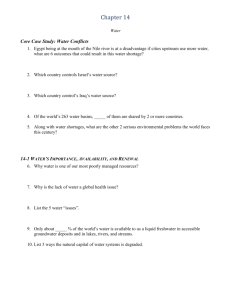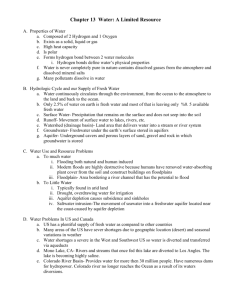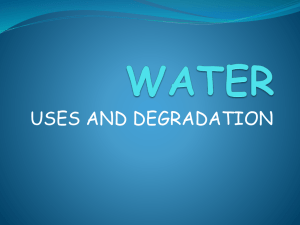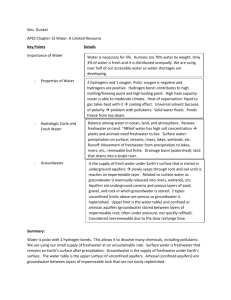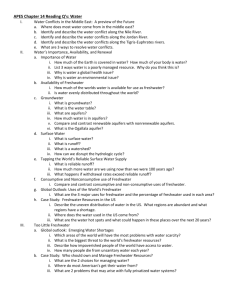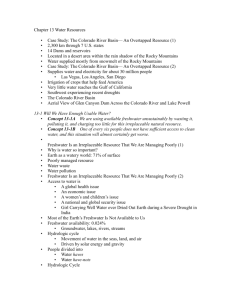freshwater resources 2014 topic 3 ppt.
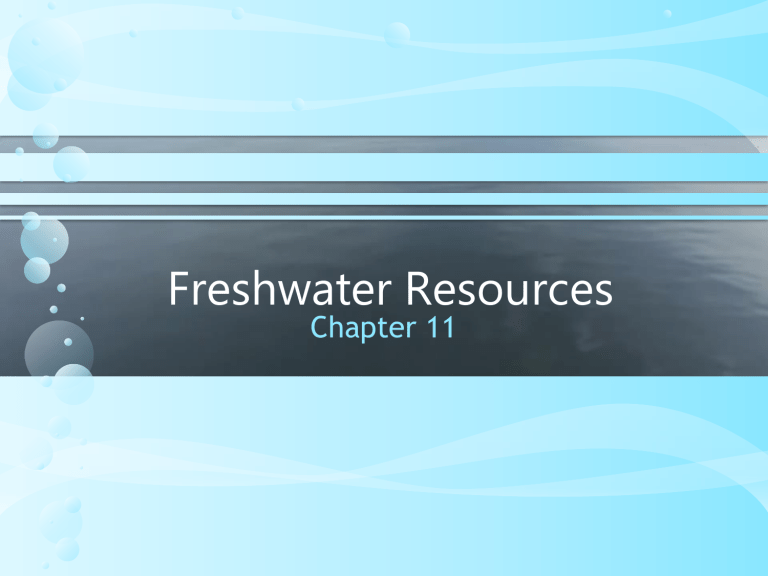
Freshwater Resources
Chapter 11
Freshwater Distribution
• About 70% of the Earth is covered with water.
• Of that, only 2.5% is considered freshwater
• 69% of freshwater is locked up in glaciers and ice caps
• 30% of freshwater is in underground aquifers
• Less than 1% of freshwater is found on the surface
Freshwater Distribution
Freshwater Per Capita
Freshwater Per Capita
• The UN estimates that 1.9 billion people (approx.
25% of the world population) will experience physical water scarcity by 2025.
• Some of the most arid countries are the ones experiencing the largest population growth.
• In many countries, water is being diverted from domestic use to industrial and agricultural uses.
• Agriculture uses 10 times as much water as humans use.
• The rub is a burgeoning population needs to eat, but industrialized food can only be produced by diverting water away from people.
Movement of Surface Water
• Water from precipitation and springs flows downhill to form streams and brooks.
• Streams and brooks merge into rivers, which makes its way to a lake, sea, or ocean.
• A small waterway flowing into a larger one is called a tributary.
• The area of land drained by a river and all of its tributaries is called a watershed .
• The watershed is like an address. The watershed address for Rockville is Rock
Creek, Potomac River, Chesapeake Bay,
Atlantic Ocean.
Movement of Surface Water
• Rivers erode soil from one bank and deposit soil along the other bank.
• This causes the river to meander (an oxbow)
• Areas where the river floods frequently are floodplains.
• Deposit of nutrient rich silt makes floodplains very fertile land and ideal for agriculture
• Riparian (riverside) zones are productive and species rich
Wetlands
• Wetlands are areas that include freshwater and dry lands. They include marshes, swamps, bogs, and fens.
• Wetlands are defined as areas that have saturated soils or include standing water for at least part of the year.
• Wetlands contain plants that are water tolerant (can withstand being submerged).
• The wetland is defined by the type of soil it contains, the vegetation it contains, and its hydrology (how the water runs off and percolates)
• Wetlands are extremely species rich and have a high productivity. They are home to many nurseries of fish and shellfish.
• Provide valuable ecosystem services like reducing runoff, recharging aquifers, filtering water, reducing erosion
• Provide human services like fishing, recreation, agricultural lands.
Wetlands
• Wetlands have been drained because they offer productive agricultural land that is nutrient rich from the accumulation of sediment. species rich and have a high productivity.
• Wetlands have also been drained because they offer high property values with scenic views of bays, oceans, etc.
• Wetland destruction – In most cases, if a developer drains a wetland, it must create another of equal size or value
• Mitigation Banking – Developers can purchase credits in a wetland bank, a large area in a different location that is sold and is turned into a wetland.
Biome Productivity
Estuaries
Swamps and marshes
Tropical rain forest
Temperate forest
Northern coniferous forest (taiga)
Savanna
Agricultural land
Woodland and shrubland
Temperate grassland
Lakes and streams
Continental shelf
Open ocean
Tundra (arctic and alpine)
Desert scrub
Extreme desert
800 1,600 2,400 3,200 4,000 4,800 5,600 6,400 7,200 8,000 8,800 9,600
Average net primary productivity (kcal/m 2 /yr)
Lakes and Ponds
• Littoral zone – water is shallow enough that aquatic plants can reach above the surface.
− High productivity and nutrient rich environment allow for high species richness
(invertebrates like crayfish and snails support birds, turtles, fish, etc.)
Lakes and Ponds
• Limnetic zone – the open portion of a lake
(away from the shore) that is penetrated by sunlight.
− Light allows for phytoplankton (autotrophic plankton) which feeds zooplankton
(heterotrophic) which feeds fish and other higher trophic level organisms
− The depth of the limnetic zone is determined by the turbidity of the water because clear water allows sunlight to penetrate to greater depths.
Lakes and Ponds
• Profundal Zone – the portion of open water that sunlight does not reach
− Lacks plant life which lowers DO and supports few animals
• Benthic Zone – the bottom of the entire water body, from the shore to the deepest point.
− Many invertebrates live in the mud and feed on detritus and each other.
Lakes and Ponds
Groundwater and Aquifers
• Some precipitation will infiltrate the ground and percolate downward into soil to become groundwater.
• Aquifers – porous, spongelike areas made of rock, sand, or gravel that hold water
• Zone of aeration – is the upper layer of an aquifer that is not completely saturated with water
• Zone of saturation – the lower layer of an aquifer that is completely saturated
• Water table – the boundary between the zone of aeration and the zone of saturation
Groundwater and Aquifers
Groundwater and Aquifers
• Artesian (confined) aquifer – an aquifer that is confined between two layers of low permeability substrate (usually clay).
− Artesian aquifers are under high pressure and in most cases when tapped, water will flow to the surface without pumping.
• Unconfined aquifer – an aquifer that is confined only by an impermeable layer on the bottom. It is easily recharged by surface water but also easily contaminated by surface pollutants.
Water Consumption
• As with most natural resources, humans are using water at an unsustainable rate.
• We are using water faster than aquifers can recharge themselves.
• Reasons for increase in water use
− Increased total population
− Increased standards of living.
• Some people predict that water may begin to play a role in regional conflicts, especially in water poor areas: Water wars?
US Water Use
• Much of the water used in the United
States is for energy production and agriculture.
• Food and energy production and transportation account for the vast majority of your water footprint.
Residential Water Use
• An average person uses around 80-100 gallons of water in the home.
• The average water footprint
(this is for all water usage including food, energy and transportation is 2000 gallons per day!
Ogallala Aquifer Case Study
• World’s largest know aquifer is the Ogallala
Aquifer in the midwest.
• Has allowed the Plain States to be so rich in agriculture.
• Currently being depleted at a rate of 1 ft per year. This is unsustainable.
• Some locations have seen water table drops of over
100 ft.
• Many farmers in this area have shifted towards crops that need less irrigation
Aral Sea Case Study
• Starting in the 1940s, the Soviet Union began using the tributaries that feed into the Aral Sea for irrigation of cotton fields.
• As a result, the Aral Sea has lost 80% of its volume.
• The water that remains is becoming more and more saline because its typical freshwater inputs are limited. (As water evaporates, it leaves the salts behind).
• What once was the sea floor are now salt laden barren areas which allow for little growth.
• The local fishing industry has collapsed leading to lower standards of living. The lower standards of living correlate to higher incidences of disease and infant mortality in the area.
Aral Sea Case Study
• Most native flora and fauna have died out and are being replaced by invasives that can tolerate the higher salinity.
• However, the cotton is the primary export of
Uzbekistan, bringing in nearly $1 billion each year.
• The World Bank is attempting to restore part of the Aral Sea.
− A dam now separates the North Aral Sea from the South
Aral Sea
− Water levels have risen in the North Aral Sea and some vegetation and fish have returned
− The South Aral Sea will probably dry out within the next
15 years. Exploration for fossil fuels will begin in the dry sea bed.
Aral Sea Crisis
Depleting Groundwater
Case Study: Mexico City
• Mexico City was originally settled on marsh land and lake beds.
• The city is densely built.
• Due to the depletion of groundwater from under the city, the ground can now support less weight. As a result, the city is sinking.
Depleting Groundwater
Case Study: Sinkholes
• Another consequence of groundwater depletion is sinkholes.
• Sinkholes typically occur in locations that have limestone formations underground.
− Florida is noted for this type of geology.
Maryland also has limestone deposits.
• Limestone is easily dissolved by acidic rainfall. The dissolution of limestone support plus a lack of support from the depleted ground water leads to cave ins.
Winter Park, Fl 1981
Guatemala City, 2007
Freshwater Per Capita
• People are not distributed across the globe in accordance with water availability.
• Most of the densely populated areas are water poor. Canada has 20 times more water per person than China.
• This requires the ability to store and move freshwater to where people need it.
• Dams have been the mechanism to harness water.
Dams
• Only a few major rivers in remote parts of
Canada, Russia, Alaska, and South America remain undammed.
Dams
• Benefits:
− Power generation with few emissions
− Storage of drinking and irrigation water
− Flood control downstream
− Allows for shipping in deeper waters
− Recreational opportunities
• Costs:
− Habitats are altered
− Migratory fish populations decline
− Reservoirs flood upstream riparian zones (nutrient rich farmland)
− Unnatural temperature changes; shallow water is much warmer, deep water in reservoir is cold
− Sediment depletion downstream
Dams
• Due to the costs sometimes outweighing the benefit, some dams are being removed.
• In recent years, about 500 dams have been removed in the US due to the dam no longer being economically viable.
Three Gorges Dam Case Study
• China’s Three Gorges Dam is the world’s largest.
− Recently completed in October 2008
− Cost $30 billion. Will supply 22,500 MW (largest amount for a hydroelectric plant)
− Required the relocation of 1.24 million people
− Accumulating sediment behind the dam already, which is degrading habitats downstream.
− Many scientists worry that pollutants will accumulate in the reservoir making the water undrinkable (Already have found high levels of bacteria)
Irrigation
• Water can be moved to areas where is it needed.
• Irrigated areas make up 18% of worldwide cropland but produce 40% of the world’s produce.
• But most irrigation is very inefficient. Only about 45% of the water supplied is actually taken up by the crop.
Irrigation
• Flood and furrow – 90% of irrigation worldwide employs this technique.
• Problem: Most of the water evaporates
Irrigation
• Low pressure spray irrigation – Much higher efficiency (80-95%) than compared to furrow irrigation.
Irrigation
• Drip Irrigation – Efficiencies in the 90% range.
How to Increase Water Supply
• Pipe water in from areas that are water rich to areas that are water poor. Example:
Colorado River; Mono Lake; Las Vegas
• Desalination - Removing salt from seawater to create freshwater. Artificially evaporate saltwater, leaving behind the salt and then artificially condense the vapor to produce freshwater.
− Many desalination plants operate in the Middle
East but they are expensive to operate
How to Reduce Water
Demand
• Use efficient irrigation methods
• Xeriscaping – landscaping with drought tolerant materials and plants
• Plant crops that match the conditions of the land.
− Water intensive crops like cotton and rice are grown in arid areas with the aid of government subsidies (the government pays for the cost of the irrigation). It doesn’t make environmental sense to grow crops where they aren’t found naturally.
• Genetically modify plants to require less water
• Municipalities keep pipes in working order
• Upgrade to more efficient machines/low flow fixtures

